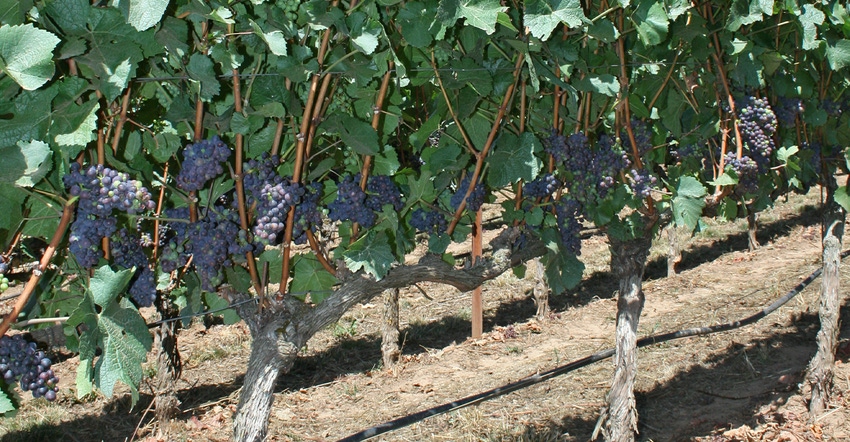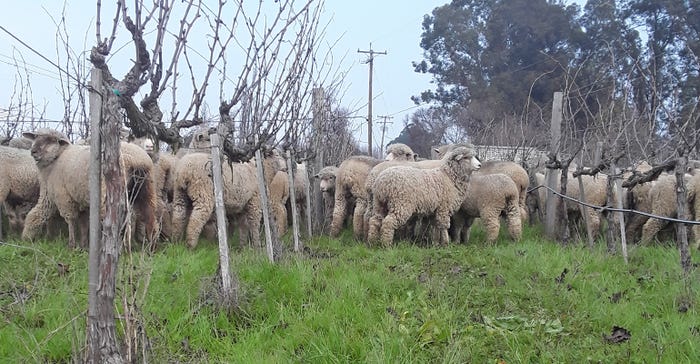October 29, 2019

Farmers of any crop work on a base of knowledge built on science and tradition, but sometimes key questions don’t get asked. That’s what’s happening in Northwest vineyards, with researchers finding that long-held ideas may not have merit.
Researchers are finding that tactics like crop thinning to boost yield and quality may not pay off as intended; and they’re learning more about pruning techniques that could save on labor costs.
In Oregon, premium winegrape growers cluster-thin grapes down to 2.5 tons of yield per acre. Growers target the same tonnage per acre, often regardless of the number of vines per acre.
“In a widely spaced vineyard,” explains Patty Skinkis, an Oregon State University horticulture professor and viticulture Extension specialist, “two-and-a-half tons of fruit would be all they could yield per acre before crop thinning. But on the high-density plantings, which became more popular in the late 1990s and early 2000s, crop thinning to two-and-a-half tons per acre cuts more than 50% of the fruit off the vine.”
OSU researchers studied crop-thinning ratios across many commercial vineyards with varying vine density per acre to determine how it impacted the yield quality. “We found few to no difference in fruit composition,” Skinkis says. “We tested this with basic ripeness parameters and phenolics, which are important wine quality indicators. When we did wine sensory evaluations with winemakers, we found neither preference for, nor alignment with, lower crop levels [cluster-thinned down to lower yield] producing a better-quality wine.”
From their studies, OSU researchers recommend growers cluster-thin yields on a basis of 1 pound per linear foot, rather than tons per acre. Growers should determine their yield potential by testing crop levels on their farms, allowing a full yield to flourish; and then measuring the actual yield against vine growth, nutrition levels and fruit quality to determine the crop-thinning level.
“It has been a long-entrenched custom in premium wine production,” explains Skinkis, “that low yields equal high quality. This has some truth, if it’s a physiological low yield. But crop thinning forces man-made low yields. Our project collaborators told us that years ago seasonal weather was out of their control, but they could control their yields. This morphed to everyone thinking crop thinning down to a two-and-a-half tons of yield per acre gave them quality, but it never was systematically tested.”
Oregon growers reviewed the study’s results; they report that with these data, they’re comfortable increasing the yield they leave on the vine by 25%.

SIDE BY SIDE: Spur pruning or cane pruning? The latter has been done traditionally, but spur pruning (left) is more easily mechanized. Oregon State University researchers found no differences in the yield or quality of winegrapes whether they’re spur- (less labor) or cane-pruned.

Pruning fallacy
Oregon is the foremost pinot noir-producing region in the world, and its growers mostly cane prune their vineyards. There are two common ways to prune: cane and spur. The latter is more easily mechanized. OSU researchers wondered why Pinot noir growers didn’t spur prune, even though it is more labor efficient.
Growers reported to OSU researchers that they couldn’t spur prune on their Pinot noir vines because the restriction of two basal buds on a dormant shoot would not produce fruit. Therefore, OSU researchers decided to test how cane pruning and spur pruning effects Pinot noir fruitfulness.
Over two crop years and three dormant seasons, researchers monitored the number of floral initials — preformed fruit clusters in the bud — under both pruning practices. They found no difference in fruitfulness on a whole plant basis and a vineyard block basis. “Whether it's cane pruned, or spur pruned, the basal buds are fruitful,” Skinkis explains. “It dispelled the myth that, if you spur prune, basal buds won’t be fruitful and that the vines won't yield.”
With this knowledge, Oregon growers now consider spur pruning for its mechanization capability. “In our outreach,” Skinkis says, “we’ve met a lot of growers who have never seen spur-pruned pinot noir vines, and they’ve worked in vineyards for 30 years. If growers switch to spur pruning, they can reduce cost through mechanization.”

GRAZING BENEFIT? University of California, Davis, researchers are looking at the value of grazing vineyards with sheep. Common in New Zealand, the practice may have value for the U.S.

Bringing sheep to the vineyard floor
Grazing sheep in vineyards is a standard practice in New Zealand and southern Europe. Sheep graze vineyards year-round in those places, because vines are on high trellis systems. In California’s Napa Valley, sheep can only graze in the vines’ dormant season because of the lower trellis systems. Growers, graziers and researchers are collaborating to study how sheep grazing affects vineyards.
Vineyard managers like grazing because it lowers input costs to control vegetation, by tillage or chemical application, on the vineyard floor. Wine customers who visit vineyards also enjoy the presence of sheep. Neighboring vineyard managers in Napa Valley now cooperatively plan grazing, so sheep can be herded across property lines to graze large swaths of landscape — without the extra labor of loading sheep into a trailer and hauling them to fresh pasture.
This all seems beneficial for the vineyards and sheep, but growers and graziers don’t know how sheep affect vine growth and crop yield. “New Zealand growers haven’t quantified the impacts of sheep in vineyards either,” explains Amélie Gaudin, University of California, Davis, plant sciences assistant professor. “In New Zealand, there are 24 million sheep and 4 million people. They integrate sheep into the vineyards because that’s the way they’ve always done it. They know they save on fertilizer, mowing, herbicide and pesticide. But they have never monetized the impact.”
UC Davis researchers implemented a study to record the economic and ecological benefits of grazing vineyards. The study also monitors the long-term impacts of soil health and carbon.
Environmental benefit
“Carbon sequestration and gas emissions are a very big emphasis in California policies,” Gaudin says. “We want to demonstrate the greenhouse gas footprint of the grazing practice. Our project just started, and it looks promising right now because you forego tractor passes. We hope it will provide a way forward into less of a carbon footprint for wine production.”
The study monitors two vineyard floor management systems: a resident vegetation no-till, and a tilled system with a planted cover crop mixed for optimal sheep nutrition. The cover crop is planted in November with common vetch, barley, Cayuse oat, Magnus winter pea and Dundale pea.
The preliminary results of this study show that grazing doesn’t negatively impact vineyards. Yield quality and quantity remain similar to control vineyards. “Some of the growers will say, anecdotally, that grazing depresses plant diseases and increases vine vigor,” Gaudin says. “Statistically, we haven’t seen any positive or negative impact of the sheep on the vines. When you apply herbicide or mow, you don’t expect any results on the vine from your practice either.”
The graziers find grazing their sheep in vineyards increases the amount of pasture available to their flocks. Growers report fewer input costs of fuel, machinery use, manual labor and chemical applications. While some vineyards pay graziers for the service, other graziers pay the vineyard for the cover crop’s forage value.
“Crops and livestock evolved together for millions of years,” Gaudin says, “and we de-coupled to reach economies of scale, et cetera. But we’re realizing now that we have problems with [concentrated] manure and cropland inputs. Grazing can provide a service in the agricultural system to reduce inputs and improve efficiency. It is logistically more complicated, for sure, but I think it can work in vineyards because we’re in a more quality-oriented market. We see it happening a little bit in walnuts right now, and I hope we get traction grazing in orchards soon.”
Along the way, recording and studying scientific data will continue to debunk assumptions and introduce helpful ag practices.
Hemken writes from Lander, Wyo.
About the Author(s)
You May Also Like




